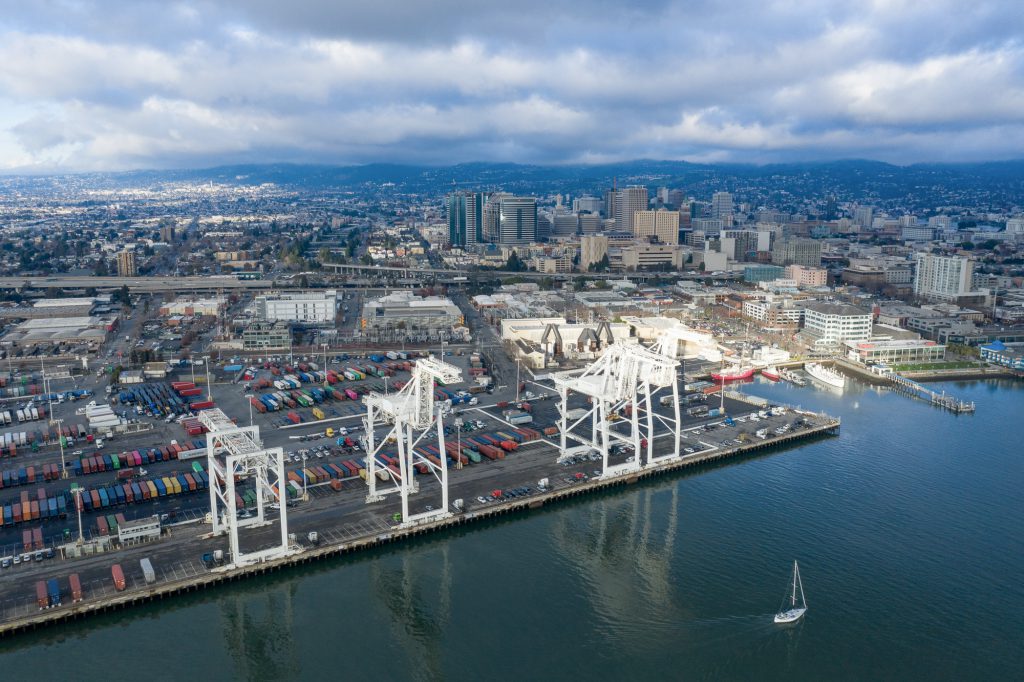Project Overview
The Port of Oakland’s Board of Port Commissioners approved a non-binding Exclusive Negotiation Term Sheet in May 2019 that gives the Oakland Athletics four years to advance their quest for a baseball stadium and mixed-use project at Howard Terminal. The Term Sheet is not a decision to build the ballpark project, but only preliminary terms and conditions for continued negotiation. A report in the Board's May 13, 2019 meeting agenda that details the term sheet can be found on the Port’s web site.
The Port of Oakland and the Oakland Athletics have been in negotiations since 2017 over their proposed project. The A’s have stated their intention to build a 35,000-seat baseball stadium to replace their current home at the Oakland Coliseum. The A’s also plan to build commercial offices, retail space, a hotel, and residential housing. Here’s the proposed site.

Howard Terminal at Port of Oakland
The ballpark would be situated on The Oakland Estuary adjacent to the Port’s Jack London Square entertainment district at the Howard Terminal site. Howard Terminal is currently one of six marine terminals at the Port of Oakland. It was last used for container cargo operations in 2013. The terminal is currently used for vessel berthing, truck and container parking and depot operations, training of longshore workers and other logistics services that support Port operations. The 50-acre site is separated from any adjacent Port-owned maritime terminal acreage by Schnitzer Steel, a metal recycling operation. Here’s a map showing the Port of Oakland seaport with Howard Terminal in the southeastern corner.
The Port has identified potential benefits from the project that include:
- More visitor traffic at Jack London Square;
- Nationwide visibility by retaining a Major League Baseball team in Oakland;
- A boost for neighboring businesses and the Oakland downtown;
- Recreational and open space opportunities.
The term sheet imposes requirements on the baseball team before the Port’s seven-member governing Board would consider a final ballpark vote. Among them:
- A completed environmental impact report on the stadium proposal;
- Land use approvals from various public agencies;
- Real estate agreements with the Port; and
- Plan and design for compatibility between seaport operations, commercial uses and residents, including traffic and use compatibility.
The term sheet does not commit the Port to the ballpark project. It states that no binding agreements would be considered before the A’s meet their obligations.
Maritime industry stakeholders (including terminal and warehouse operators, labor and truck drivers) have expressed concerns about the proposed ballpark. The concerns center primarily on:
- loss of waterfront land for seaport operations;
- the potential for conflicts between the seaport operations, including Port-related truck traffic and water navigation, and the ballpark project (particularly residential uses and game-day traffic);
- the potential loss of maritime jobs, both those at Howard Terminal and beyond; and
In response to these concerns, the Port, in its term sheet, has stipulated conditions:
- The Port reserves to the Port the right to develop an expansion of the Inner Harbor turning basin on Oakland Estuary of up to approximately 10 acres of Howard Terminal. The Inner Harbor turning basin accommodates the turning of larger cargo ships in the Estuary.
- Residential development would be permitted only on land on the side further away from industrial and maritime operations and adjacent to the ballpark itself.
- The development project would include a comprehensive transportation and circulation plan to minimize vehicular congestion and avoid conflicts between vehicular and pedestrian traffic generated by the Project and seaport operations, including cargo trucks.
- Any final real estate agreement would include measures, designs, and operational standards, developed in consultation with seaport and maritime stakeholders, to ensure that the Project does not impact or interfere with the Port’s current or reasonably anticipated future use, operation, and development of Port facilities, or the health and safety of Port tenants and workers.
























